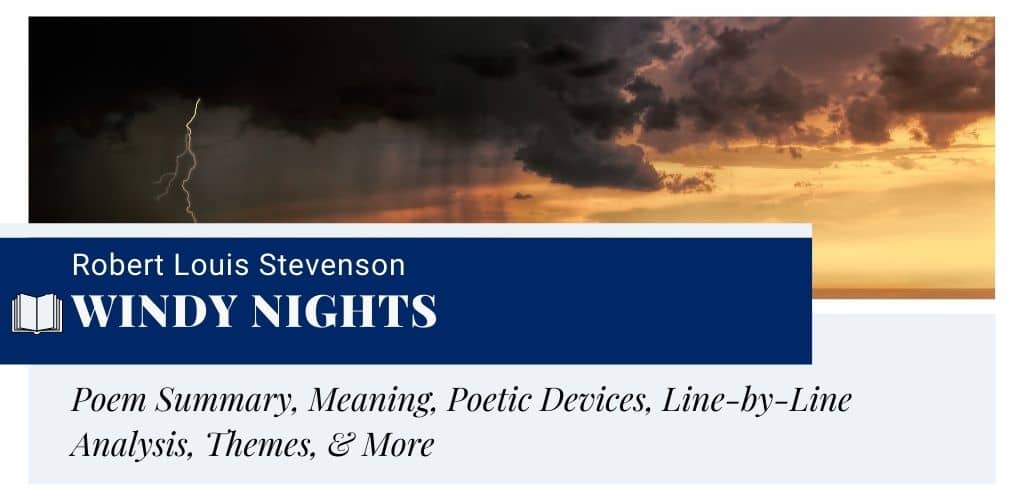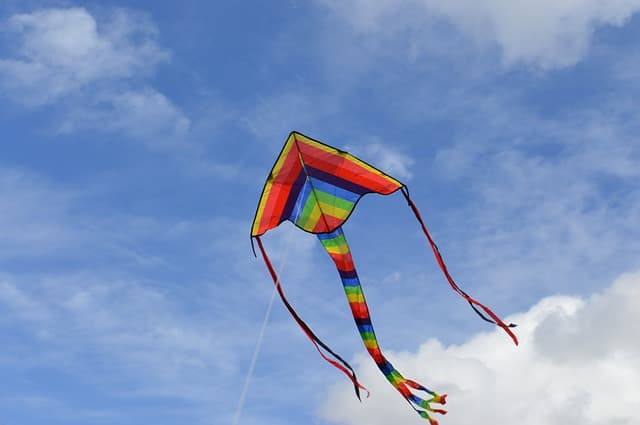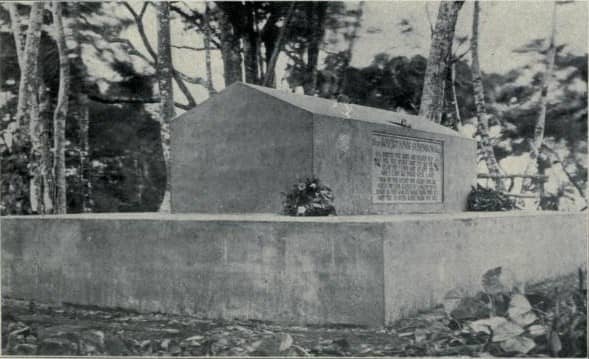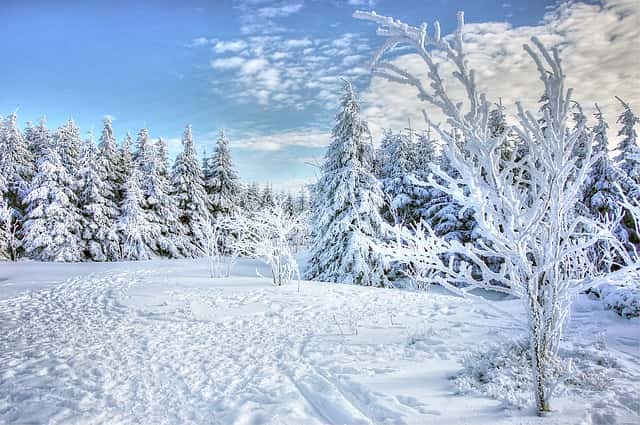Windy Nights by Robert Louis Stevenson
“Windy Nights” is a poem from Robert Louis Stevenson’s most influential collection of poetry, A Child’s Garden of Verses. This beautiful poem encapsulates the heart with its winding sounds and makes us think regarding the horse rider’s identity. Is it a figure from a fairy tale or purely a creation of childish imagination? The answer is implicit. It can be the personification of the stormy wind or a thing that cannot be seen. Whatsoever, Stevenson makes us think deeply through this simple verse recording the night scene during a rapacious storm.
- Read the full text of “Windy Nights”:
Windy Nights
by Robert Louis Stevenson
Whenever the moon and stars are set,
Whenever the wind is high,
All night long in the dark and wet,
A man goes riding by.
Late in the night when the fires are out,
Why does he gallop and gallop about?
Whenever the trees are crying aloud,
And ships are tossed at sea,
By, on the highway, low and loud,
By at the gallop goes he.
By at the gallop he goes, and then
By he comes back at the gallop again.
- from A Child's Garden of Verses (1885)

Summary
The poem “Windy Nights” refers to a universal image of nature before the storm. Stevenson describes how the night sky gets covered with clouds, hiding the moon and stars. When the wind blows fast along with incessant rain, the poetic persona (representing a child) can hear a man riding by. He rages with his horse against the darkness of the night.
The second stanza describes the stormy night scene further. Stevenson depicts how the storm topples trees and tosses ships at sea. However, on the highway, the rider goes on. At the gallop, he goes and returns similarly.
Meaning
The title of the poem “Windy Nights” is a reference to the main idea of the poem. Through the title, Stevenson gives a hint of the subject matter. It is about a stormy night scene. However, it does not help readers to dive deeper into the text. For understanding the overall meaning, one has to dive deeper into lines. When they do so, they can find a world full of mystery and signs. The sudden appearance of a horse rider makes one thoughtful regarding his identity. However, after reading the text, it becomes clear that the rider is a personified representation of the stormy wind. It can also be a mysterious figure, an imaginary character of childhood fantasy.
Form, Rhyme Scheme, & Meter
Form
“Windy Nights” is a children’s poem that consists of two stanzas. Each stanza contains six lines. It is written from the perspective of a child who details the night scene. The sing-song-like structure of the poem makes it an example of a lyric.
Rhyme Scheme
This poem contains a regular rhyme scheme. In the first stanza, the first four lines contain the alternative ABAB rhyme scheme. The rest of the lines form a rhyming couplet. So, the overall rhyme scheme is ABABCC. For example, in the first four lines “set” and “wet”, and “high” and “sky” rhyme together. While the last two lines end with a different rhyming pair “out” and “about”.
This scheme is followed in the next stanza. The rhyming of the last two lines is a bit irregular as here Stevenson tries to rhyme “then” with “again”. It is an example of an imperfect rhyme.
Meter
The overall poem is composed of the iambic tetrameter and iambic trimeter alternatively. It means each line either consists of four or three iambic (unstressed-stressed) beats. There are a few variations as well. Let’s have a look at the scansion of the first stanza in order to understand how the lines should be read and stressed.
When-ever/ the moon/ and stars/ are set,
When-ever/ the wind/ is high,
All night/ long in/ the dark/ and wet,
A man/ goes rid/-ing by.
Late in/ the night/ when the fires/ are out,
Why does/ he gallop/ and gallop/ a-bout?
Poetic Devices & Figurative Language
In Stevenson’s “Windy Nights”, the following poetic devices can be found:
- Anaphora: It occurs in the first two lines. Both of these lines begin with the word “Whenever”. It also occurs in the last four lines.
- Personification: Stevenson personifies the stormy wind. He invests with the idea of riding a horse. It also occurs in “Whenever the trees are crying aloud”.
- Repetition: In the last three lines, the poet repeats the phrase “By at the gallop goes he”. He uses three variations of the same line in order to create an intricate rhyming.
- Rhetorical Question: It occurs in the last line of the first stanza “Why does he gallop and gallop about?”
- Alliteration: The repetition of similar sounds can be found in “stars are set”, “gallop and gallop”, “low and loud”, etc.
- Onomatopoeia: In the poem, the sound of the storm resonates with the galloping sound of a horse.
Line-by-Line Analysis & Explanation
Lines 1-6
Whenever the moon and stars are set,
Whenever the wind is high,
All night long in the dark and wet,
A man goes riding by.
Late in the night when the fires are out,
Why does he gallop and gallop about?
The title of the poem “Windy Nights” sets the tone and mood at the very onset. It creates a sense of mystery and fear in readers’ minds. There is also a sense of uncertainty at the very beginning.
However, the poem begins with an image familiar to the audience. It describes how the gloomy clouds cover the sky just before the storm. Stevenson compares this scene to that of the sunset. His persona thinks as if the moon and stars are set like the sun. But, they are still there just behind the clouds.
According to the persona, whenever the wind blows high and it starts raining, he can hear the sound of a man riding by. The speaker cannot see him but he can sense his presence by the very sound. This simple sound sparks his imaginative mind. It is actually the sound of the gust.
This personifies stormy wind rides into the darkness late in the night, without bothering the rain. When the fires are out at night, the rider gallops by. In the last line, the speaker poses a rhetorical question to readers. He asks why the rider gallops about. It is a mystery hard to comprehend.
Lines 7-12
Whenever the trees are crying aloud,
And ships are tossed at sea,
By, on the highway, low and loud,
By at the gallop goes he.
By at the gallop he goes, and then
By he comes back at the gallop again.
In the second stanza, Stevenson describes how the ferocious creates havoc in nature. It seems to the speaker as if the storm makes the trees afraid. They start crying aloud whenever the storm comes. Here, the poet compares the sound originating from the haphazard movement of trees to crying.
The storm makes the sea restless, resulting in the tossing of ships. In this way, the poet creates a tense and tremulous mood inside the text. The horse rider does not fear such a restlessness in nature. He keeps riding on the highway by making low and loud sounds.
In the following lines, Stevenson repeats the phrase “By at the gallop goes he”. This repetition hints at a sense of continuation. It means the rider continues his journey without bothering the storm. At the gallop of his horse, he goes. Then he comes back in a similar way. The movement of the rider reflects the swift and directionless course of the stormy wind.
Themes
Stevenson’s “Windy Nights” taps on the themes of childhood imagination, fantasy, nature, and mystery. The poem begins with the theme of nature. Steven beautifully describes a stormy night scene. The appearance of a storm alongside its heavy sound creates a sense of mystery. Stevenson’s persona, who represents a child, imagines the storm to be a man riding a horse. From this section, the theme of childhood imagination and fantasy comes into play. The poet employs the theme in order to portray how a child can recreate reality in his mind by using the auditory and visual elements available to him.
Imagery
Stevenson makes use of the following types of images in this poem.
- Visual Imagery: The poem begins with a visual image of the night sky and how it gets covered by storm clouds.
- Auditory Imagery: The poet uses this imagery in the usage of words “gallop” and “crying”. The first word is used to convey the sound of the storm and the second one resonates with the sound made by trees during a storm.
- Organic Imagery: This type of imagery is used to portray the feelings of the child during the storm. For example, the line “Why does he gallop and gallop about” conveys a sense of mystery and confusion in a reader’s mind.
- Kinesthetic Imagery: The lines “Whenever the trees are crying aloud,/ And ships are tossed at sea” contain kinesthetic imagery. Here, the movement of the trees and the tossing of ships are portrayed.
Historical Context
The poem “Windy Nights” was first published in Robert Louis Stevenson’s collection of poetry, A Child’s Garden of Verses. This collection of 64 poems was published in 1885. It is written from the point of view of a child. Stevenson dedicated this book of poetry to his childhood nurse, Alison Cunningham. A children’s book of 1880 inspired him to write this collection. The book has been reprinted several times, often in illustrated versions. It is considered one of the influential children’s books of the 19the century. The best-loved poems from this collection include “My Shadow”, “The Lamplighter”, and “From a Railway Carriage”.
Questions & Answers
Robert Louis Stevenson’s poem “Windy Nights” is about a storm during the night. In this poem, the poet describes how a child imagines the storm to be a horse rider. The sound of the storm makes him think so.
The title of the poem is a reference to stormy nights. In this poem, Stevenson describes how a storm appears and continues to blow furiously throughout the night.
This poem consists of two six-line stanzas. Each stanza contains a quatrain followed by a rhyming couplet.
It is a lyric poem having a regular rhyme scheme and meter. Stevenson wrote this poem from the point of view of a child.
In this line, Stevenson uses personification in order to compare the sound of tossing trees to that of crying. It seems the trees are afraid of the storm.
This phrase means whenever the wind blows at a higher pace. It is a hint at the approaching storm.
It occurs in the lines “All night long in the dark and wet,/ A man goes riding by.” This device is also used in the following lines. Stevenson employs this device to internally connect the lines.
Explore More Poems from A Child’s Garden of Verses
External Resources
- Full Text of A Child’s Garden of Verse: Selected Poems — Read the full text of some more poems from Stevenson’s book of poetry.
- About A Child’s Garden of Verses — Explore more about the poetry collection and the adaptations of the poems published in it.
- About Robert Louis Stevenson — Read about the poet’s life and his works.
- Biography of Stevenson and His Poems — Learn more about the poet and explore more of his poems.





